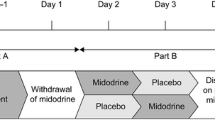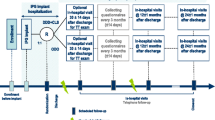Summary
The pharmacological response with tilt-table testing predicts long-term efficacy in neurocardiogenic syncope. However, beta-blockers for neurocardiogenic syncope are often not tolerated or are ineffective. Since cholinergic tone is important in the efferent part of the neurocardiogenic reflex, we investigated the pharmacodynamics and efficacy of propantheline bromide in preventing neurocardiogenic syncope. We studied 16 patients (11 males) with a mean age of 48.8 (± 15.1) years with presyncope or syncope and who had positive baseline tilt-table studies at a mean of 15.8 (± 10.3) minutes into the upright 60° tilt. They were given propantheline bromide orally, an anticholinergic agent, at a dose of 64.3 (± 21.8) mg/day for 7 days, and tilt-table testing was repeated 1 hour after readministration of propantheline bromide, 30 mg orally. After propantheline bromide treatment, 13 of 16 patients (81%) had no inducible presyncope or syncope on repeat tilt-table testing. In this group of responders, the mean minimum heart rate during upright tilt-table testing increased from 43.2 (± 77.3) beats/min to 77.3 (± 17.2) beats/min after propantheline bromide (p<0.005). More significantly, the minimum mean arterial blood pressure increased from 42.2 (± 25) mmHg to 81.3 (± 16.7) mmHg (p<0.0005) during upright tilt. At a follow-up of 15.2 (± 7.4) months, in the responder group (12 patients with long-term follow-up), the average dose of propantheline bromide was 32.5 (± 23.8) mg/day, which was significantly reduced from the initial dose (p<0.05). A clinical recurrence of symptoms occurred in only 4 out of 12 patients on propantheline bromide (33%), none of which were directly attributable to drug failure. It was concluded from this study that propantheline bromide is highly effective in preventing neurocardiogenic syncope. In addition, propantheline bromide's effectiveness is more than would be expected by prevention of cardioinhibition in neurocardiogenic syncope and would support a role for direct cholinergic control of vascular tone.
Similar content being viewed by others
References
Sra, JS, Jazayeri, MR, Dhala, A, Deshpande, S, Blanck, Z, Akhtar, M. Neurocardiogenic syncope: Diagnosis, mechanisms, and treatment. Cardiol Clin 1993;11:183–191.
Sheldon R. Tilt table testing in the diagnosos and treatment of syncope. Cardiovasc Rev Reports 1994:8–27.
Palmer, RA. The treatment of carotid sinus syncope with probantheline. Cana Med Assoc J 1971;104:923–925.
Sugrue, DD, Wood, DL, McGoon, MD. Carotid sinus hypersensitivity and syncope. Mayo Clin Proc 1994;59:637–640.
Guberman, A, Catching, J. Swallow syncope. Can J Neurol Sci 1986;13:267–269.
Kappor, WN. Syncope with abrupt termination of exercise. Am J Med 1989;87:597–599.
Huycke, EC, Card, HG, Sobol, SM, Nguyen, NX, Sung, RJ. Postexertional cardiac asystole in a young man without organic heart disease. Ann Intern Med 1987;106:844–845.
American Society of Hospital Pharmacists. Selected Revisions: Antimuscarinics/Antispasmodics, February 1991, 12:707–703.
Brown, JH. Atropine, scopalamine, and related antimuscarinic drugs. In: Gilman, AG, Rall, TW, Mies, AS, Taylor, P, eds. Goodman and Gillman's The Pharmacological Basis of Therapeutics. New York: Pergamon, 1990:150–165.
McLaran, CJ, Gersh, BJ, Osborn, MJ, Wood, DJ, Sugrue, DD, Holmes, DRJr, Hammill, SC. Increased vagal tone as an isolated finding in patients undergoing electrophysiological testing for recurrent syncope: Response to long term anticholinergic agents. Br Heart J 1986;55:53–57.
Madrid, AH, Lazaro, M, Ayala, I, Corraliza, JP, Picart, MS. Vagotonia sintomatica en pacientes jovenes. Datos clinicos Y actitud terapeutica. Arch Inst Cardiol Mex 1990;60: 191–194.
Pai, GR, Rawles, JM. A case of respiratory sinus arrhythmia and vasovagal attacks: Use of cosinor analysis for diagnosis and for monitoring treatment. Br Heart J 1987;57:555–557.
Vanhoutte, PM, Levy, MN. Prejunctional cholinergic modulation of adrenergic neurotransmission in the cardiovascular system. Am J Physiol 1980;238:H275-H281.
Loffelholz, K, Muscholl, E. Inhibition by parasympathetic nerve stimulation of the release of adrenergic transmitter. Naunyn Schmiedebergs Arch Pharmacol 1970;267:181–184.
Levy, MN, Blattberg, B. Effect of vagal stimulation on the overflow of norepinephrine into the coronary sinus during cardiac sympathetic stimulation in the dog. Circ Res 1976; 38:81–84.
Muscholl, E. Peripheral muscarinic control of norepinephrine release in the cardiovascular system. Am J Physiol 1980;239:H713-H720.
Fuder, H, Kilbinger, H, Muller, H. Organ selectivity of hexahydrosiladifenidol in blocking pre- and post-junctional muscarinic receptors studied in guinea pig ileum and rat heart. Eur J Pharmacol 1985;113:125–127.
Dammann, F, Fuder, H, Giachetti, A, et al. AF-DX 116 differentiates between prejunctional muscarine receptors located on noradrenergic and cholinergic nerves. Nanuyn Schmiedebergs Arch Pharmacol 1989;339:268–271.
Pappano, AJ. Modulation of the heartbeat by the vagus nerve. In: Zipes, DP, Jalife, J, eds. Cardiac Electrophysiology from Cell to Bedside. Philadelphia: WB Saunders, 1995: 411–422.
Morillo, CA, Klein, GJ, Gersh, BJ. Can serial tilt testing be used to evaluate therapy in neurally medicated syncope? Am J Cardiol 1996;77:52–53.
Author information
Authors and Affiliations
Additional information
This work was presented in part at the American Heart Association 67th Scientific Sessions, Dallas, Texas, November 14, 1994.
Rights and permissions
About this article
Cite this article
Yu, J.C.L., Sung, R.J. Clinical efficacy of propantheline bromide in neurocardiogenic syncope: Pharmacodynamic implications. Cardiovasc Drug Ther 10, 687–692 (1997). https://doi.org/10.1007/BF00053025
Received:
Accepted:
Issue Date:
DOI: https://doi.org/10.1007/BF00053025




